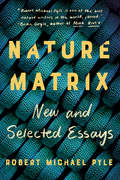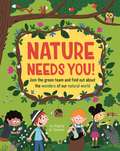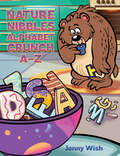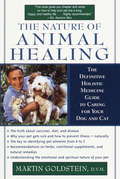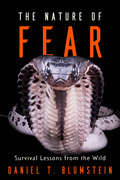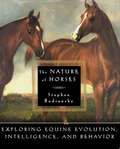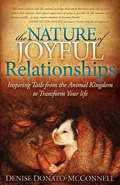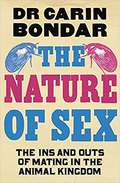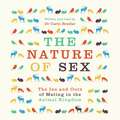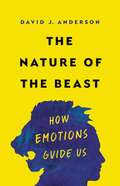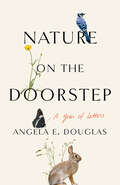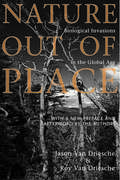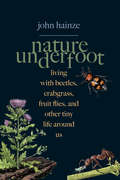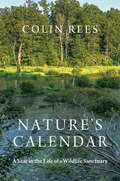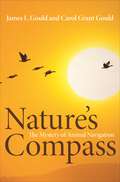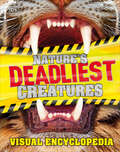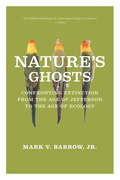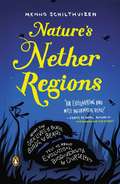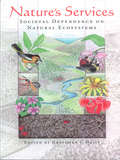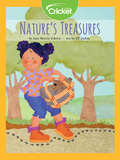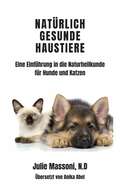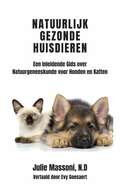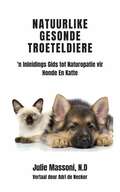- Table View
- List View
Nature Matrix: New and Selected Essays
by Robert Michael PyleNature Matrix is a gathering of some of Robert Michael Pyle’s most significant, original, and timely expressions of a life immersed in the natural world, in all its splendor, power, and perilNature Matrix: New and Selected Essays contains sixteen pieces that encompass the philosophy, ethic, and aesthetic of Robert Michael Pyle. The essays range from Pyle’s experience as a young national park ranger in the Sierra Nevada to the streets of Manhattan; from the suburban jungle to the tangles of the written word; and from the phenomenon of Bigfoot to that of the Big Year—a personal exercise in extreme birding and butterflying. They include deep profiles of John Jacob Astor I and Vladimir Nabokov, as well as excursions into wild places with teachers, children, and writers.The nature of real wilderness in modern times comes under Pyle’s lens, as does reconsideration of his trademark concept, “the extinction of experience”—maybe the greatest threat of alienation from the living world that we face today.Nature Matrix shows a way back toward possible integration with the world, as it plumbs the range and depth of experience in one lucky life lived in close connection to the physical earth and its denizens. This collection brings together the thoughts and hopes of one of our most widely read and respected natural philosophers as he seeks to summarize a life devoted to conservation.
Nature Needs You!: Join the Green Team and find out about the wonders of our natural world
by Liz GogerlyFour friends, Anjali, Lulu, Mason and Noah, discover an injured fox in the garden and need to take it to an animal rescue centre. There, they begin a year of discovery learning about the amazing animals, plants and places that make up our natural world.As the year goes on the children talk to lots of different people, from park rangers and environmentalists, to teachers and grandparents. They learn lots of things about the natural world, from biodiversity, food chains and climate change to pollination, plastic pollution and ecosystems.Throughout there are 'Take Action' advice panels, which give examples of small ways that people can get involved to help protect nature.Get Busy activity suggestions encourage children to be actively engaged with nature, by birdwatching or planting wild flowers.There are also full-page, step-by-step activities for how to make a bug hotel and a bird feeder.By the end of the book, readers will have a better understanding of the importance of nature, humans impact on nature and what can be done to help protect itLook out for the other titles in this series: Go Green, Wild Weather and Save our Seas.
Nature Nibbles: Alphabet Crunch A-Z
by Jenny WishNature Nibbles: Alphabet Crunch A-Z celebrates the twist and turn of letters in rhyme. Whimsical and wacky, nature bites their way to unexpected choices. Children will giggle their way in fun while learning the alphabet. This charming little book celebrates unleashed imagination for the early learner and their parents. Nibble away!
The Nature of Animal Healing: The Definitive Holistic Medicine Guide to Caring for Your Dog and Cat
by Martin GoldsteinGoldstein (D. V. M. , Cornell U. College of Veterinary Medicine) espouses a holistic approach to pet care and argues that conventional methods can cause or complicate ill health in pets. Writing primarily for the concerned pet owner, he offers alternatives to commercial pet foods and presents examples of various symptoms he's successfully treated with holistic methods. The book includes an extensive annotated resource guide that comprises listings of product manufacturers as well as excerpts from Helen McKinnon's book citing printed materials, web sites, associations, and veterinarians sympathetic to the cause. Annotation c. Book News, Inc. , Portland, OR (booknews. com)
The Nature of Fear: Survival Lessons From The Wild
by Daniel T. BlumsteinA leading expert in animal behavior takes us into the wild to better understand and manage our fears.Fear, honed by millions of years of natural selection, kept our ancestors alive. Whether by slithering away, curling up in a ball, or standing still in the presence of a predator, humans and other animals have evolved complex behaviors in order to survive the hazards the world presents. But, despite our evolutionary endurance, we still have much to learn about how to manage our response to danger.For more than thirty years, Daniel Blumstein has been studying animals’ fear responses. His observations lead to a firm conclusion: fear preserves security, but at great cost. A foraging flock of birds expends valuable energy by quickly taking flight when a raptor appears. And though the birds might successfully escape, they leave their food source behind. Giant clams protect their valuable tissue by retracting their mantles and closing their shells when a shadow passes overhead, but then they are unable to photosynthesize, losing the capacity to grow. Among humans, fear is often an understandable and justifiable response to sources of threat, but it can exact a high toll on health and productivity.Delving into the evolutionary origins and ecological contexts of fear across species, The Nature of Fear considers what we can learn from our fellow animals—from successes and failures. By observing how animals leverage alarm to their advantage, we can develop new strategies for facing risks without panic.
The Nature of Horses: Exploring Equine Evolution, Intelligence, and Behavior
by Stephen BudianskyA scientific look at the origins, behavior, intelligence and language of the horse, based on cutting-edge research on horses' vision, biology and movement. Horses have a shared history with man going back millennia to their domestication around 4000 B. C. Yet only in very recent years have scientists begun to turn the tools of modern science on this remarkable animal that has been so wrapped up in human dreams and legends. Now modern scientific research is beginning to explain long-standing mysteries about the true nature of the horse. How well can horses really see? What causes breakdowns in racehorses? How intelligent are they compared to other animals, and are some breeds smarter than others? Does nature or nurture matter more in creating a great sport horse? What causes cribbing and other vices? In this beautifully illustrated, compelling narrative, Budiansky tells the story of the origins, behavior, intelligence and language of the horse. For the first time, horse lovers will have access to cutting-edge research on topics of interest including new information on horse vision, horse biology and movement. Introducing the latest archeological findings, Budiansky presents a fascinating discussion of how the horse evolved as well as a dramatic and provocative history of man's use and abuse of the horse from prehistoric times to today. In a revealing chapter on horse intelligence, he debunks the commonly held belief that horses are stupid and also presents compelling new scientific information on horse language which will greatly benefit the horse rider and trainer. Finally, drawing together the latest research on horse physiology, genetics and biomechanics, Budiansky asks the million dollar question -- what makes for a winning racehorse? Anyone who loves horses will find this an invaluable resource as well as a fascinating read.
The Nature of Joyful Relationships: Inspiring Tails from the Animal Kingdom to Transform Your Life
by Denise Donato-McConnellHave you ever asked yourself any of these questions? Am I creating my relationships from a place of love and compassion? Isn't it just part of our animal nature to react with fear and anger? How do I change my perspective to create the healthy, joyful relationships I so desire? The author found answers in what may seem an unlikely group of teachers:
The Nature of Sex: The Ins and Outs of Mating in the Animal Kingdom
by Carin BondarThought about sex today? Of course you have! It's about the most natural thing any animal can do. But have you ever wondered how human sex compares to that of other beasts? It's far from merely inserting part A into slot B. The sex lives of our animal cousins are fiendishly difficult, infinitely varied and often violent. They involve razor-sharp penises, murderous cannibals and chemical warfare in an epic battle between the sexes.Join renowned biologist Dr Carin Bondar on a fascinating journey from puberty to old age across the entire animal kingdom - it will forever change your idle daydreams about the nature of sex.
The Nature of Sex: The Ins and Outs of Mating in the Animal Kingdom
by Dr Carin BondarThought about sex today? Of course you have! It's about the most natural thing any animal can do. But have you ever wondered how human sex compares to that of other beasts? It's far from merely inserting part A into slot B. The sex lives of our animal cousins are fiendishly difficult, infinitely varied and often violent. They involve razor-sharp penises, murderous cannibals and chemical warfare in an epic battle between the sexes.Join renowned biologist Dr Carin Bondar on a fascinating journey from puberty to old age across the entire animal kingdom - it will forever change your idle daydreams about the nature of sex.
The Nature of Sex: The Ins and Outs of Mating in the Animal Kingdom
by Dr Carin BondarNarrated by the author.Thought about sex today? Of course you have! It's about the most natural thing any animal can do. But have you ever wondered how human sex compares to that of other beasts? It's far from merely inserting part A into slot B. The sex lives of our animal cousins are fiendishly difficult, infinitely varied and often violent. They involve razor sharp penises, murderous cannibals and chemical warfare in an epic battle between the sexes.Like us, animals must first find the perfect partner. You think we have it tough? Try having to do it while being hunted down by predators, against a backdrop of unpredictable or life-threatening conditions. Then, sperm and egg must successfully meet. Can you imagine doing this when your partner is intent on killing you or when other disgruntled singles are determined to throw you off your game? The next task is to ensure that the resultant offspring reach sexual maturity in order to keep the cycle going. The myriad ways in which this is accomplished is ingenious.Join Carin Bondar on a fascinating journey from puberty to old age across the entire animal kingdom - it will forever change your idle daydreams about the nature of sex.(p) 2015 Orion Publishing Group
The Nature of the Beast: How Emotions Guide Us
by David J. AndersonA pioneering neuroscientist offers a new way of understanding how emotions drive behaviorDoes your dog get sad when you leave for the day? Does your cat purr because she loves you? Do bears attack when they&’re angry? You can&’t very well ask them. In fact, scientists haven&’t been able to reach a consensus on whether animals even have emotions like humans do, let alone how to study them. Yet studies of animal emotion are critical for understanding human emotion and mental illness. In The Nature of the Beast, pioneering neuroscientist David J. Anderson describes a new approach to solving this problem. He and his colleagues have figured out how to study the brain activity of animals as they navigate real-life scenarios, like fleeing a predator or competing for a mate. His research has revolutionized what we know about animal fear and aggression. Here, he explains what studying emotions and related internal brain states in animals can teach us about human behavior, offering new insights into why isolation makes us more aggressive, how sex and violence connect, and whether there&’s a link between aggression and mental illness. Full of fascinating stories, The Nature of the Beast reconceptualizes how the brain regulates emotions–and explains why we have them at all.
Nature on the Doorstep: A Year of Letters
by Angela E. DouglasNature on the Doorstep reveals the simple pleasures of paying attention to the natural world in one's own backyard over the course of a year. In weekly letters, Angela Douglas shares the joys and curiosities of a decidedly ordinary patch of green in upstate New York cultivated through the art of "strategic neglect"—sometimes taking a hand to manage wildlife, more often letting nature go its own way. From the first flowers of spring to cardinals singing in the winter, Douglas shows us the magic of welcoming unexpected plant and animal life into one's backyard. A paean to the richness we find when we stop to look and let be, Nature on the Doorstep celebrates the role humble backyards play both in conservation efforts and in an expanded appreciation of the living world.
Nature Out of Place: Biological Invasions In The Global Age
by Jason Van Driesche Roy Van DriescheThough the forests are still green and the lakes full of water, an unending stream of invasions is changing many ecosystems around the world from productive, tightly integrated webs of native species to loose assemblages of stressed native species and aggressive invaders. The earth is becoming what author David Quammen has called a "planet of weeds." Nature Out of Place brings this devastating but overlooked crisis to the forefront of public consciousness by offering a fascinating exploration of its causes and consequences, along with a thoughtful and practical consideration of what can be done about it. The father and son team of Jason and Roy Van Driesche offer a unique combination of narratives that highlight specific locations and problems along with comprehensive explanations of the underlying scientific and policy issues.Chapters examine Hawaii, where introduced feral pigs are destroying the islands' native forests; zebra mussel invasion in the rivers of Ohio; the decades-long effort to eradicate an invasive weed on the Great Plains; and a story about the restoration of both ecological and human history in an urban natural area. In-depth background chapters explain topics ranging from how ecosystems become diverse, to the characteristics of effective invaders, to procedures and policies that can help prevent future invasions. The book ends with a number of specific suggestions for ways that individuals can help reduce the impacts of invasive species, and offers resources for further information.By bringing the problem of invasive species to life for readers at all levels, Nature Out of Place will play an essential role in the vital effort to raise public awareness of this ongoing ecological crisis.
Nature Underfoot: Living with Beetles, Crabgrass, Fruit Flies, and Other Tiny Life Around Us
by John HainzeAn informed and heartfelt tribute to commonly unappreciated plants, insects, and other tiny creatures that reconsiders humanity&’s relationship to nature Fruit flies, silverfish, dandelions, and crabgrass are the bane of many people and the target of numerous chemical and physical eradication efforts. In this compelling reassessment of the relationship between humans and the natural world, John Hainze—an entomologist and former pesticide developer—considers the fascinating and bizarre history of how these so-called invasive or unwanted pests and weeds have coevolved with humanity and highlights the benefits of a greater respect and moral consideration toward these organisms. With deep insight into the lives of the underappreciated and often reviled creatures that surround us, Hainze&’s accessible and engaging natural history draws on ethics, religion, and philosophy as he passionately argues that creepy crawlies and unwanted plants deserve both empathy and accommodation as partners dwelling with us on earth.
Nature's Calendar: A Year in the Life of a Wildlife Sanctuary
by Colin ReesTake an enchanting journey through the shifting seasons in a wildlife sanctuary home to wetland, forest, and grassland and supporting an incredible diversity of plants and animals.Flocks of waterfowl exploding into steely skies above frozen marshland, salamanders creeping across the forest floor to vernal pools, chorusing frogs peeping their ecstasy while warblers crowd budding trees, turtles sunning on floating logs, the ecological engineering of beavers—these are but a few of the sights and sounds marking a year at Jug Bay Wetlands Sanctuary and its neighboring landscapes in Southern Maryland. In an absorbing account of a year in the life of this sanctuary, naturalist Colin Rees invites us to join him as he explores the secrets and wonders of the changing natural world. Alongside the author, we witness spring's avian migrations, quickening of aquatic vegetation, burgeoning of myriad invertebrates, and the assaults of extreme weather conditions. We revel in summertime's proliferation of fish, fowl, and mammals. We become attuned to the shifting climate's impacts on autumnal transitions, and we marvel at amazing feats of biological inventiveness in preparation for winter conditions. Through these visions of the fleeting—and yet enduring—cycles of nature, Rees shares deep insights into the ecological and behavioral dynamics of the natural environment. Enhanced by more than two dozen color plates, the book touches on a wide range of issues, from microbial diversity, bird banding, and butterfly phenology to genetic diversity and habitat fragmentation. It also examines the challenges of conserving these and other natural features in the face of climate change and development pressures. Thoughtful and lyrical, Nature's Calendar speaks to all readers, scientific and lay alike. Fascinating profiles of flora and fauna celebrate the richness and complexity of a unique ecosystem, exploring the entire ecology of this dynamic and delicate area.
Nature's Compass: The Mystery of Animal Navigation (Science Essentials #16)
by James L. Gould Carol Grant GouldThe mysterious and remarkable ways that animals navigateWe know that animals cross miles of water, land, and sky with pinpoint precision on a daily basis. But it is only in recent years that scientists have learned how these astounding feats of navigation are actually accomplished. With colorful and thorough detail, Nature's Compass explores the remarkable methods by which animals find their way both near home and around the globe. Noted biologist James Gould and popular science writer Carol Gould delve into the elegant strategies and fail-safe backup systems, the invisible sensitivities and mysterious forces, and incredible mental abilities used by familiar and rare species, as they investigate a multitude of navigation strategies, from the simple to the astonishing.The Goulds discuss how animals navigate, without instruments and training, at a level far beyond human talents. They explain how animals measure time and show how the fragile monarch butterfly employs an internal clock, calendar, compass, and map to commence and measure the two-thousand-mile annual journey to Mexico—all with a brain that weighs only a few thousandths of an ounce. They look at honey bees and how they rely on the sun and mental maps to locate landmarks such as nests and flowers. And they examine whether long-distance migrants, such as the homing pigeon, depend on a global positioning system to let them know where they are. Ultimately, the authors ask if the disruption of migratory paths through habitat destruction and global warming is affecting and endangering animal species.Providing a comprehensive picture of animal navigation and migration, Nature's Compass decodes the mysteries of this extraordinary aspect of natural behavior.
Nature's Deadliest Creatures Visual Encyclopedia (DK Children's Visual Encyclopedias)
by DKCome face-to-face with 150 of the world's scariest killer creatures, from the lion and great white shark to the tarantula, anaconda snake, golden eagle, vampire bat, and even the fierce ant!The book profiles every kind of animal--mammals, reptiles, birds, fish, insects, and arachnids. Chapters are arranged according to how these dangerous predators kill. Do they use jaws and claws, venom, stings, traps, tricks and cunning, or mass invasion?With more than 200 spectacular photos in the book, every page has a stunning image of the animal in action, with data files giving a visual guide to its size, distribution, diet, and habitat, as well as a rating of its "scare factor."Each profile features bite-size text that will appeal to all readers. Discover key facts about how the animal lives (is it solitary or a pack animal?), intriguing anatomy (the platypus is famously one of the few venomous mammals, but did you know that the venom comes from the hind leg on the males only?), and of course, their method of attack (such as chasing prey to exhaustion, launching an ambush, or paralyzing with poison).Further fascinating facts can also be found in the reference section at the end of book, including deadly defense, family trees, toxins, and prehistoric deadly creatures that are no more.
Nature's Ghosts: Confronting Extinction from the Age of Jefferson to the Age of Ecology
by Mark V. Barrow Jr.A historical narrative of endangered animals and the dedicated individuals who have studied and struggled to protect them, offering an unprecedented view of what we've lost and a stark reminder of the hard work of preservation still ahead.
Nature's Nether Regions
by Menno SchilthuizenA tour of evolution's most inventive--and essential--creations: animal genitaliaForget opposable thumbs and canine teeth: the largest anatomical differences between humans and chimps are found below the belt. In Nature's Nether Regions, ecologist and evolutionary biologist Menno Schilthuizen invites readers to discover the wondrous diversity of animalian reproductive organs. Schilthuizen packs this delightful read with astonishing scientific insights while maintaining an absorbing narrative style reminiscent of Mary Roach and Jerry Coyne. With illustrations throughout and vivid field anecdotes--among them laser surgery on a fruit fly's privates and a snail orgy--Nature's Nether Regions is a celebration of life in all shapes and sizes. understand our own unique place in the great diversity of life.
Nature's Nether Regions
by Menno SchilthuizenThe story of evolution as you've never heard it before What's the easiest way to tell species apart? Check their genitals. Researching private parts was long considered taboo, but scientists are now beginning to understand that the wild diversity of sex organs across species can tell us a lot about evolution. Menno Schilthuizen invites readers to join him as he uncovers the ways the shapes and functions of genitalia have been molded by complex Darwinian struggles: penises that have lost their spines but evolved appendages to displace sperm; female orgasms that select or reject semen from males, in turn subtly modifying the females' genital shape. We learn why spiders masturbate into miniature webs, discover she dungflies that store sperm from attractive males in their bellies, and see how, when it comes to outlandish appendages and bizarre behaviors, humans are downright boring. Nature's Nether Regions joyfully demonstrates that the more we learn about the multiform private parts of animals, the more we understand our own unique place in the great diversity of life.
Nature's Services: Societal Dependence On Natural Ecosystems
by Stephen Carpenter Gretchen Daily Les Kaufman Kamaljit Bawa Charles H. Peterson Sandra PostelLife itself as well as the entire human economy depends on goods and services provided by earth's natural systems. The processes of cleansing, recycling, and renewal, along with goods such as seafood, forage, and timber, are worth many trillions of dollars annually, and nothing could live without them. Yet growing human impacts on the environment are profoundly disrupting the functioning of natural systems and imperiling the delivery of these services.Nature's Services brings together world-renowned scientists from a variety of disciplines to examine the character and value of ecosystem services, the damage that has been done to them, and the consequent implications for human society. Contributors including Paul R. Ehrlich, Donald Kennedy, Pamela A. Matson, Robert Costanza, Gary Paul Nabhan, Jane Lubchenco, Sandra Postel, and Norman Myers present a detailed synthesis of our current understanding of a suite of ecosystem services and a preliminary assessment of their economic value. Chapters consider: major services including climate regulation, soil fertility, pollination, and pest control philosophical and economic issues of valuation case studies of specific ecosystems and services implication of recent findings and steps that must be taken to address the most pressing concerns Nature's Services represents one of the first efforts by scientists to provide an overview of the many benefits and services that nature offers to people and the extent to which we are all vitally dependent on those services. The book enhances our understanding of the value of the natural systems that surround us and can play an essential role in encouraging greater efforts to protect the earth's basic life-support systems before it is too late.
Nature's Treasures
by Jane Morris UdovicA young girl learns about the wonders of nature in this rhyming poem.
Natürlich gesunde Haustiere
by Julie Massoni A. M. A.Natürlich gesunde Haustiere ist eine Einführung in die Naturheilkunde für Hunde und Katzen und beinhaltet Informationen über natürliche Ernährung und Nahrungsergänzungsmittel, um die Gesundheit Ihres Tieres zu verbessern. Ebenso enthalten sind Informationen zur Anwendung von Käräutern, Homöopathie und Blütenessenzen zur Unterstützung von Gesundheit und Wohlbefinden. Es werden natürliche Alternativen zur Behandlung von Floh- und Wurmbefall, Alternativen zu Antibiotika und zu Schmerzmitteln vorgestellt und Informationen über die vegetarische Ernährung von Hunden vermittelt. Es handelt sich um ein Buch, das von einer qualifizierten Tierheilpraktikerin geschrieben wurde, die schon tausenden von Tieren mit einer Reihe akuter und chronischer Erkrankungen helfen konnte. Wenn Sie mehr über die Verwendung natürlicher Therapiemethoden und die Vermeidung vieler Gesundheitsprobleme erfahren möchten, dann ist dieses Buch eine großartige Wahl.
Natuurlijk Gezonde Huisdieren - Een Inleidende Gids over Natuurgeneeskunde voor Honden en Katten
by Julie MassoniNatuurlijk Gezonde Huisdieren is een inleidende gids over natuurgeneeskunde voor honden en katten. Hij bevat informatie over natuurlijke voeding en voedingssupplementen om de gezondheid van je dieren te verbeteren, alsook informatie over het gebruik van kruiden, homeopathie en Bachbloesems, om gezondheid en welzijn te bevorderen. Ook natuurlijke alternatieven voor vlooienbestrijding, ontworming, antibiotica en pijnbestrijding komen aan bod. Deze gids bevat eveneens informatie over het voeren van een vegetarisch dieet aan honden. Geschreven door een gekwalificeerd Veterinair Natuurgeneeskundige, die duizenden dieren met een waaier aan acute en chronische gezondheidsproblemen heeft geholpen. Als je meer wil weten over het gebruik van natuurlijke therapieën en hoe je veel gezondheidsproblemen kan voorkomen, dan is dit boek een uitstekende referentie.
Natuurlike Gesonde Troeteldiere - ‘n Inleidings Gids tot Naturopatie vir Honde En Katte
by Julie Massoni Vertaal deur Adri de NeckerNatuurlike Gesonde Troeteldiere is ‘n inleidings gids tot naturopatie vir honde en katte en sluit inligting in oor ‘n natuurlike dieet, voedings aanvullings om jou dier se gesondheid te verbeter asook inligting oor die gebruik van kruie, homeopatie en blom ekstrakte om te help met gesondheid en welstand. Natuurlike alternatiewe vir vlooie, ontwurming, antibiotikas en pyn verligting. Sluit ook inligting in oor die voer van ‘n vegetariese dieet vir honde. Geskryf deur ‘n gekwalifiseerde dier naturopaat wat al duisende diere gehelp het wat ‘n reeks van akuut en chroniese gesondheids toestande het. As jy daarvan sal hou om meer te weet oor die gebruik van natuurlike terapie en hoe om baie gesondheids probleme te vermy, dan is hierdie boek ‘n goeie verwysing.
